Incumbents defeated


+1 Dem House Seat +2 Dem House Seats
+3-4 Dem House Seats +7 Dem House Seats
Both parties won 2 seats and lost 2 seats, no net change
In primary elections
Democrats
Three Democrats (including one non-voting delegate) lost renomination.
- Guam at-large: Delegate Madeleine Bordallo lost renomination to Michael San Nicolas, who then won the general election.[1][2]
- Massachusetts 7: Mike Capuano lost renomination to Ayanna Pressley, who then won the general election.[3]
- New York 14: Joe Crowley lost renomination to Alexandria Ocasio-Cortez, who then won the general election.[3]
Republicans
Two Republicans lost renomination.[3]
- North Carolina 9: Robert Pittenger lost renomination to Mark Harris. A new special election was ordered due to electoral fraud conducted by associates of Republican Harris's campaign.[a]
- South Carolina 1: Mark Sanford lost renomination to Katie Arrington, who then lost the general election to Joe Cunningham (D).
In the general election
Democrats
No Democrats lost re-election to Republicans.[4]
Republicans
Thirty Republicans lost re-election to Democrats.[4]
- California 10: Jeff Denham (first elected in 2010) lost to Josh Harder.
- California 21: David Valadao (first elected in 2012) lost to TJ Cox.
- California 25: Steve Knight (first elected in 2014) lost to Katie Hill.
- California 45: Mimi Walters (first elected in 2014) lost to Katie Porter.
- California 48: Dana Rohrabacher (first elected in 1988) lost to Harley Rouda.
- Colorado 6: Mike Coffman (first elected in 2008) lost to Jason Crow.
- Florida 26: Carlos Curbelo (first elected in 2014) lost to Debbie Mucarsel-Powell.
- Georgia 6: Karen Handel (first elected in 2017) lost to Lucy McBath.
- Illinois 6: Peter Roskam (first elected in 2006) lost to Sean Casten.
- Illinois 14: Randy Hultgren (first elected in 2010) lost to Lauren Underwood.
- Iowa 1: Rod Blum (first elected in 2014) lost to Abby Finkenauer.
- Iowa 3: David Young (first elected in 2014) lost to Cindy Axne.
- Kansas 3: Kevin Yoder (first elected in 2010) lost to Sharice Davids.
- Maine 2: Bruce Poliquin (first elected in 2014) lost to Jared Golden.
- Michigan 8: Mike Bishop (first elected in 2014) lost to Elissa Slotkin.
- Minnesota 2: Jason Lewis (first elected in 2016) lost to Angie Craig.
- Minnesota 3: Erik Paulsen (first elected in 2008) lost to Dean Phillips.
- New Jersey 3: Tom MacArthur (first elected in 2014) lost to Andy Kim.
- New Jersey 7: Leonard Lance (first elected in 2008) lost to Tom Malinowski.
- New York 11: Dan Donovan (first elected in 2015) lost to Max Rose.
- New York 19: John Faso (first elected in 2016) lost to Antonio Delgado.
- New York 22: Claudia Tenney (first elected in 2016) lost to Anthony Brindisi.[5]
- Oklahoma 5: Steve Russell (first elected in 2014) lost to Kendra Horn.
- Pennsylvania 17: Keith Rothfus (first elected in 2012) lost a redistricting race to Conor Lamb.
- Texas 7: John Culberson (first elected in 2000) lost to Lizzie Fletcher.
- Texas 32: Pete Sessions (first elected in 1996) lost to Colin Allred.
- Utah 4: Mia Love (first elected in 2014) lost to Ben McAdams.
- Virginia 2: Scott Taylor (first elected in 2016) lost to Elaine Luria.
- Virginia 7: Dave Brat (first elected in 2014) lost to Abigail Spanberger.
- Virginia 10: Barbara Comstock (first elected in 2014) lost to Jennifer Wexton.
Open seats that changed parties
Democratic seats won by Republicans
Three Democratic seats were won by Republicans.
- Minnesota 1: Won by Jim Hagedorn.[6]
- Minnesota 8: Won by Pete Stauber.[7]
- Pennsylvania 14: Conor Lamb instead ran in the 17th district. Won by Guy Reschenthaler.[7]
Republican seats won by Democrats
Thirteen Republican seats were won by Democrats.
- Arizona 2: Won by Ann Kirkpatrick.
- California 39: Won by Gil Cisneros.
- California 49: Won by Mike Levin.
- Florida 27: Won by Donna Shalala.
- Michigan 11: Won by Haley Stevens.
- New Jersey 2: Won by Jeff Van Drew, who became a Republican on December 19, 2019.[8]
- New Jersey 11: Won by Mikie Sherrill.
- New Mexico 2: Won by Xochitl Torres Small.
- Pennsylvania 5: Won by Mary Gay Scanlon.
- Pennsylvania 6: Won by Chrissy Houlahan.
- Pennsylvania 7: Won by Susan Wild.
- South Carolina 1: Won by Joe Cunningham.
- Washington 8: Won by Kim Schrier.
Open seats that parties held
Democratic seats held by Democrats
Democrats held nineteen of their open seats.
- Arizona 9: Won by Greg Stanton.
- Colorado 2: Won by Joe Neguse.
- Connecticut 5: Won by Jahana Hayes.
- Hawaii 1: Won by Ed Case.
- Illinois 4: Won by Chuy García.
- Maryland 6: Won by David Trone.
- Massachusetts 3: Won by Lori Trahan.
- Michigan 9: Won by Andy Levin.
- Michigan 13: Won by Rashida Tlaib.
- Minnesota 5: Won by Ilhan Omar.
- Nevada 3: Won by Susie Lee.
- Nevada 4: Won by Steven Horsford.
- New Hampshire 1: Won by Chris Pappas.
- New Mexico 1: Won by Deb Haaland.
- New York 25: Won by Joe Morelle.
- Pennsylvania 2: Bob Brady retired. Won By Brendan Boyle.
- Pennsylvania 4: Brendan Boyle ran in Pennsylvania 2. Won by Madeleine Dean.
- Texas 16: Won by Veronica Escobar.
- Texas 29: Won by Sylvia Garcia.
Republican seats held by Republicans
Republicans held twenty-eight of their open seats.
- Florida 6: Won by Michael Waltz.
- Florida 15: Won by Ross Spano.
- Florida 17: Won by Greg Steube.
- Idaho 1: Won by Russ Fulcher.
- Indiana 4: Won by Jim Baird.
- Indiana 6: Won by Greg Pence.
- Kansas 2: Won by Steve Watkins.
- Mississippi 3: Won by Michael Guest.
- North Dakota at-large: Won by Kelly Armstrong.
- Ohio 16: Won by Anthony Gonzalez.
- Oklahoma 1: Won by Kevin Hern.
- Pennsylvania 9: Won by Dan Meuser.
- Pennsylvania 13: Won by John Joyce.
- South Carolina 4: Won by William Timmons.
- South Dakota at-large: Won by Dusty Johnson.
- Tennessee 2: Won by Tim Burchett.
- Tennessee 6: Won by John Rose.
- Tennessee 7: Won by Mark Green.
- Texas 2: Won by Dan Crenshaw.
- Texas 3: Won by Van Taylor.
- Texas 5: Won by Lance Gooden.
- Texas 6: Won by Ron Wright.
- Texas 21: Won by Chip Roy.
- Virginia 5: Won by Denver Riggleman.
- Virginia 6: Won by Ben Cline.
- West Virginia 3: Won by Carol Miller.
- Wisconsin 1: Won by Bryan Steil.
Resignations
Three other members announced their retirements but then resigned early before their terms ended.
- Texas 27: Blake Farenthold (R) announced his retirement December 14, 2017. He resigned on April 6, 2018. His seat was filled by a special election for the remainder of the term.
- Utah 3: Jason Chaffetz (R) announced his retirement April 19, 2017. He resigned on June 30, 2017. His seat was filled by a special election for the remainder of the term.
- West Virginia 3: Evan Jenkins (R) announced his retirement May 8, 2017 to run for U.S. Senator.[9] He lost the nomination and then resigned September 30, 2018, when appointed to the Supreme Court of Appeals of West Virginia. His seat was not filled until the regular election for the next congress.
 | |||||||||||||||||
| |||||||||||||||||
| |||||||||||||||||
 County results Welch: 40–50% 50–60% 60–70% 70–80% | |||||||||||||||||
| |||||||||||||||||
| Elections in Vermont |
|---|
 |
 | ||||||||||||||||||||
| ||||||||||||||||||||
| Turnout | 53.7% ( 7.5%) 7.5%) | |||||||||||||||||||
|---|---|---|---|---|---|---|---|---|---|---|---|---|---|---|---|---|---|---|---|---|
| ||||||||||||||||||||
 County results Evers: 40–50% 50–60% 60–70% 70–80% Walker: 40–50% 50–60% 60–70% 70–80% | ||||||||||||||||||||
| ||||||||||||||||||||
| Elections in Wisconsin |
|---|
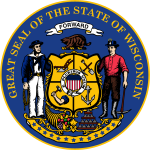 |
The following list of birds of New York includes the 494 species and a species pair of wild birds documented in New York as of July 2020. Unless noted otherwise, the source is the Checklist of New York State Birds published by the New York State Avian Records Committee (NYSARC) of the New York State Ornithological Association.[10] These species represent 23 orders and 67 families of birds. An additional, "hypothetical", species is also noted by NYSARC.
This list is presented in the taxonomic sequence of the Check-list of North and Middle American Birds, 7th edition through the 61st Supplement, published by the American Ornithological Society (AOS).[11] Common and scientific names are also those of the Check-list, except that the common names of families are from the Clements taxonomy because the AOS list does not include them.
Unless otherwise noted, all species listed below are considered to occur regularly in New York as permanent residents, summer/winter visitors, or migrants. These tags are used to annotate some species:
- (B) Breeding - a species that currently breeds or has bred in New York (248 species)
- (†) Extinct - a species that used to live in what is now New York but is now extinct (2 or 3 species)
- (E) Extirpated - a species that no longer occurs in New York, but populations exist elsewhere (2 species)
- (I) Introduced - a population established solely as result of direct or indirect human intervention; synonymous with non-native and non-indigenous (8 species)
- (IE) - an introduced population existed but is now extirpated (2 species)
- (H) Hypothetical - a species with sight records but no description, specimen, or photograph (1 species)
Other markings denote birds that NYSARC requests documentation of in certain conditions:
- (N) - documentation of this species should be submitted if seen anywhere in New York (153 species)
- (U) - documentation of this species should be submitted if seen in upstate New York (30 species)
- (D) - documentation of this species should be submitted if seen in downstate New York (4 species)
- (A) - documentation of this species should be submitted if seen outside the Adirondacks (3 species)
- (P) - documentation of this species should be submitted if seen outside of the pelagic zone (between 3 and 200 miles from shore) but within New York State. (4 species)
- (S) - documentation of this species should be submitted if seen in New York in spring (3 species)
Ducks, geese, and waterfowl


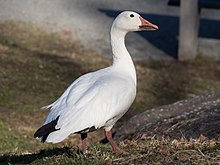
Order: Anseriformes Family: Anatidae
The family Anatidae includes the ducks and most duck-like waterfowl, such as geese and swans. These birds are adapted to an aquatic existence with webbed feet, bills which are flattened to a greater or lesser extent, and feathers that are excellent at shedding water due to special oils. Thirty-nine species have been recorded in New York.
- Snow goose, Anser caerulescens
- Greater white-fronted goose, Anser albifrons (N)
- Brant, Branta bernicla
- Barnacle goose, Branta leucopsis (N)
- Cackling goose, Branta hutchinsii (N)
- Canada goose, Branta canadensis (B)
- Mute swan, Cygnus olor (I)
- Tundra swan, Cygnus columbianus (N)
- Wood duck, Aix sponsa
- Blue-winged teal, Spatula discors (N)
- Northern shoveler, Spatula clypeata
- Gadwall, Mareca strepera (B)
- Eurasian wigeon, Mareca penelope (N)
- American wigeon, Mareca americana
- Mallard, Anas platyrhynchos (B)
- American black duck, Anas rubripes (B)
- Northern pintail, Anas acuta
- Green-winged teal, Anas crecca
- Canvasback, Aythya valisineria
- Redhead, Aythya americana (N)
- Ring-necked duck, Aythya collaris
- Tufted duck, Aythya fuligula (N)
- Greater scaup, Aythya marila
- Lesser scaup, Aythya affinis
- King eider, Somateria spectabilis (N)
- Common eider, Somateria mollissima (N)
- Surf scoter, Melanitta perspicillata (N)
- White-winged scoter, Melanitta deglandi(N)
- Black scoter, Melanitta americana (N)
- Long-tailed duck, Clangula hyemalis
- Bufflehead, Bucephala albeola
- Common goldeneye, Bucephala clangula
- Barrow's goldeneye, Bucephala islandica (N)
- Hooded merganser, Lophodytes cucullatus
- Common merganser, Mergus merganser
- Red-breasted merganser, Mergus serrator
- Ruddy duck, Oxyura jamaicensis
New World quail
Order: Galliformes Family: Odontophoridae
The New World quails are small, plump terrestrial birds only distantly related to the quails of the Old World, but named for their similar appearance and habits. One species has been recorded in New York.
- Northern bobwhite, Colinus virginianus (E)
Pheasants, grouse, and allies
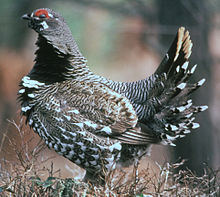
Order: Galliformes Family: Phasianidae
Phasianidae consists of the pheasants and their allies. These are terrestrial species, variable in size but generally plump with broad relatively short wings. Many species are gamebirds or have been domesticated as a food source for humans. Two species have been recorded in New York.
- Wild turkey, Meleagris gallopavo (N)
- Ring-necked pheasant, Phasianus colchicus (I,E)
Grebes

Order: Podicipediformes Family: Podicipedidae
Grebes are small to medium-large diving birds that breed on fresh water. They have lobed toes and are excellent swimmers and divers. However, they have their feet placed far back on the body, making them quite ungainly on land. Three species have been recorded in New York.
- Pied-billed grebe, Podilymbus podiceps
- Horned grebe, Podiceps auritus
- Red-necked grebe, Podiceps grisegena (N)
Pigeons and doves


Order: Columbiformes Family: Columbidae
Pigeons and doves are stout-bodied birds with short necks and short slender bills with a fleshy cere. Five species have been recorded in New York.
- Rock pigeon, Columba livia (I)(B)
- Eurasian collared-dove, Streptopelia decaocto (N)
- Passenger pigeon, Ectopistes migratorius (†)
- White-winged dove, Zenaida asiatica (N)
- Mourning dove, Zenaida macroura (B)
Cuckoos
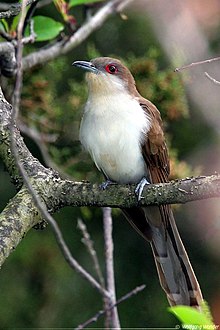
Order: Cuculiformes Family: Cuculidae
The family Cuculidae includes cuckoos, roadrunners, and anis. These birds are of variable size with slender bodies, long tails, and strong legs. Two species have been recorded in New York.
- Yellow-billed cuckoo, Coccyzus americanus
- Black-billed cuckoo, Coccyzus erythropthalmus
Nightjars and allies

Order: Caprimulgiformes Family: Caprimulgidae
Nightjars are medium-sized nocturnal birds that usually nest on the ground. They have long wings, short legs, and very short bills. Most have small feet, of little use for walking, and long pointed wings. Their soft plumage is cryptically colored to resemble bark or leaves. Three species have been recorded in New York.
- Common nighthawk, Chordeiles minor
- Chuck-will's-widow, Antrostomus carolinensis (N)
- Eastern whip-poor-will, Antrostomus vociferus (N)
Swifts
Order: Apodiformes Family: Apodidae
The swifts are small birds which spend the majority of their lives flying. These birds have very short legs and never settle voluntarily on the ground, perching instead only on vertical surfaces. Many swifts have long swept-back wings which resemble a crescent or boomerang. One species has been recorded in New York.
- Chimney swift, Chaetura pelagica (B)
Hummingbirds
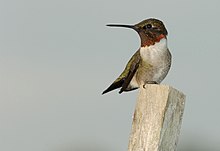
Order: Apodiformes Family: Trochilidae
Hummingbirds are small birds capable of hovering in mid-air due to the rapid flapping of their wings. They are the only birds that can fly backwards. Three species have been recorded in New York.
- Ruby-throated hummingbird, Archilochus colubris (B)
- Calliope hummingbird, Selasphorus calliope (N)
- Rufous hummingbird, Selasphorus rufus (N)
Rails, gallinules, and coots

Order: Gruiformes Family: Rallidae
Rallidae is a large family of small to medium-sized birds which includes the rails, crakes, coots, and gallinules. The most typical family members occupy dense vegetation in damp environments near lakes, swamps, or rivers. In general they are shy and secretive birds, making them difficult to observe. Most species have strong legs and long toes which are well adapted to soft uneven surfaces. They tend to have short rounded wings and to be weak fliers. Six species have been recorded in New York.
- Clapper rail, Rallus crepitans (N)
- Virginia rail, Rallus limicola
- Sora, Porzana carolina (N)
- Common gallinule, Gallinula galeata (N)
- American coot, Fulica americana
- Purple gallinule, Porphyrio martinicus (N)
Cranes

Order: Gruiformes Family: Gruidae
Cranes are large, long-legged, and long-necked birds. Unlike the similar-looking but unrelated herons, cranes fly with necks outstretched, not pulled back. Most have elaborate and noisy courting displays or "dances". One species has been recorded in New York.
- Sandhill crane, Antigone canadensis (N)
Stilts and avocets
Order: Charadriiformes Family: Recurvirostridae
Recurvirostridae is a family of large wading birds which includes the avocets and stilts. The avocets have long legs and long up-curved bills. The stilts have extremely long legs and long, thin, straight bills. One species has been recorded in New York.
- American avocet, Recurvirostra americana (N)
Oystercatchers
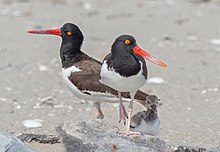
Order: Charadriiformes Family: Haematopodidae
The oystercatchers are large, obvious, noisy plover-like birds with strong bills used for smashing or prying open molluscs. One species has been recorded in New York.
- American oystercatcher, Haematopus palliatus (N)
Plovers and lapwings

Order: Charadriiformes Family: Charadriidae
The family Charadriidae includes the plovers, dotterels, and lapwings. They are small to medium-sized birds with compact bodies, short thick necks, and long, usually pointed, wings. They are found in open country worldwide, mostly in habitats near water. Four species have been recorded in New York.
- Black-bellied plover, Pluvialis squatarola
- American golden-plover, Pluvialis dominica (N)
- Killdeer, Charadrius vociferus (B)
- Semipalmated plover, Charadrius semipalmatus
Sandpipers and allies


Order: Charadriiformes Family: Scolopacidae
Scolopacidae is a large, diverse family of small to medium-sized shorebirds which includes the sandpipers, curlews, godwits, shanks, tattlers, woodcocks, snipes, dowitchers, and phalaropes. Most species eat small invertebrates picked out of the mud or soil. Different lengths of legs and bills enable multiple species to feed in the same habitat, particularly on the coast, without direct competition for food. Twenty-two species have been recorded in New York.
- Upland sandpiper, Bartramia longicauda (N)
- Whimbrel, Numenius phaeopus (N)
- Ruddy turnstone, Arenaria interpres (N)
- Red knot, Calidris canutus (N)
- Sanderling, Calidris alba
- Dunlin, Calidris alpina
- Purple sandpiper, Calidris maritima
- Least sandpiper, Calidris minutilla
- White-rumped sandpiper, Calidris fuscicollis (N)
- Pectoral sandpiper, Calidris melanotos (N)
- Semipalmated sandpiper, Calidris pusilla
- Western sandpiper, Calidris mauri (N)
- Short-billed dowitcher, Limnodromus griseus (N)
- American woodcock, Scolopax minor
- Wilson's snipe, Gallinago delicata (N)
- Spotted sandpiper, Actitis macularia
- Solitary sandpiper, Tringa solitaria
- Lesser yellowlegs, Tringa flavipes
- Willet, Tringa semipalmata (N)
- Greater yellowlegs, Tringa melanoleuca
- Red-necked phalarope, Phalaropus lobatus (N)
- Red phalarope, Phalaropus fulicarius (N)
Skuas and jaegers
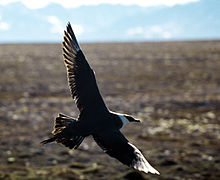
Order: Charadriiformes Family: Stercorariidae
Skuas and jaegers are long-distant migrants, breeding on the high arctic tundra but flying as far as Antarctica. During the breeding season, they hunt small mammals and birds, but at other times of the year they will scavenge and steal food from other birds. Two species have been recorded in New York.
- South polar skua, Stercorarius maccormicki (N)
- Pomarine jaeger, Stercorarius pomarinus (N)
Auks, murres, and puffins
Order: Charadriiformes Family: Alcidae
Alcids are superficially similar to penguins in their black-and-white colors, their upright posture, and some of their habits. However they are only distantly related to the penguins and are able to fly. Auks live on the open sea, deliberately coming ashore only to nest. Two species have been recorded in New York.
Gulls, terns, and skimmers
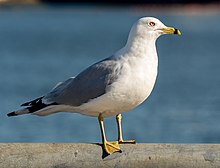

Order: Charadriiformes Family: Laridae
Laridae is a family of medium to large seabirds and includes jaegers, skuas, gulls, terns, kittiwakes, and skimmers. They are typically gray or white, often with black markings on the head or wings. They have stout, longish bills and webbed feet. Twenty-two species have been recorded in New York.
- Black-legged kittiwake, Rissa tridactyla (N)
- Bonaparte's gull, Chroicocephalus philadelphia (N)
- Black-headed gull, Chroicocephalus ridibundus (N)
- Laughing gull, Leucophaeus atricilla
- Franklin's gull, Leucophaeus pipixcan (N)
- Ring-billed gull, Larus delawarensis
- Herring gull, Larus smithsonianus (B)
- Iceland gull, Larus glaucoides
- Lesser black-backed gull, Larus fuscus (N)
- Glaucous gull, Larus hyperboreus (N)
- Great black-backed gull, Larus marinus (B)
- Sooty tern, Onychoprion fuscatus (N)
- Bridled tern, Onychoprion anaethetus (N)
- Least tern, Sternula antillarum (N)
- Caspian tern, Hydroprogne caspia (N)
- Black tern, Chlidonias niger (N)
- Common tern, Sterna hirundo (B)
- Forster's tern, Sterna forsteri (N)
- Royal tern, Thalasseus maximus (N)
- Sandwich tern, Thalasseus sandvicensis (N)
- Elegant tern, Thalasseus elegans (N)
- Black skimmer, Rynchops niger
Tropicbirds
Order: Phaethontiformes Family: Phaethontidae
Tropicbirds are slender white birds of tropical oceans with exceptionally long central tail feathers. Their long wings have black markings, as does the head. One species has been recorded in New York.
- White-tailed tropicbird, Phaethon lepturus (N)
Loons

Order: Gaviiformes Family: Gaviidae
Loons are aquatic birds the size of large ducks, which they superficially resemble. Their plumage is largely gray or black, and they have spear-shaped bills. Loons swim well and fly adequately, but, because their legs are placed towards the rear of the body, are not well adapted to locomotion on land. Three species have been recorded in New York.
- Red-throated loon, Gavia stellata
- Pacific loon, Gavia pacifica (N)
- Common loon, Gavia immer
Southern storm-petrels
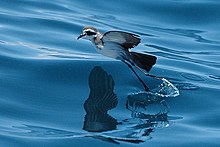
Order: Procellariiformes Family: Oceanitidae
The storm-petrels are the smallest seabirds, relatives of the petrels, feeding on planktonic crustaceans and small fish picked from the surface, typically while hovering. The flight is fluttering and sometimes bat-like. Until 2018, the family's three species were included with the other storm-petrels in family Hydrobatidae. One species has been recorded in New York.
- Wilson's storm-petrel, Oceanites oceanicus (N)
Northern storm-petrels
Order: Procellariiformes Family: Hydrobatidae
Though the members of this family are similar in many respects to the southern storm-petrels, including their general appearance and habits, there are enough genetic differences to warrant their placement in a separate family. Two species have been recorded in New York.
- Leach's storm-petrel, Hydrobates leucorhous (N)
- Band-rumped storm-petrel, Hydrobates castro (N)
Shearwaters and petrels
Order: Procellariiformes Family: Procellariidae
The procellariids are the main group of medium-sized "true petrels", characterized by united nostrils with medium septum and a long outer functional primary. One species has been recorded in New York.
- Great shearwater, Ardenna gravis (N)
Boobies and gannets

Order: Suliformes Family: Sulidae
The sulids comprise the gannets and boobies. Both groups are medium-large coastal seabirds that plunge-dive for fish. Two species have been recorded in New York.
- Brown booby, Sula leucogaster (N)
- Northern gannet, Morus bassanus (N)
Anhingas
Order: Suliformes Family: Anhingidae
Anhingas are cormorant-like water birds with very long necks and long, straight beaks. They are fish eaters which often swim with only their neck above the water. One species has been recorded in New York.
- Anhinga, Anhinga anhinga (N)
Cormorants and shags

Order: Suliformes Family: Phalacrocoracidae
Cormorants are medium to large aquatic birds, usually with mainly dark plumage and areas of colored skin on the face. The bill is long, thin, and sharply hooked. Their feet are four-toed and webbed. Two species have been recorded in New York.
- Great cormorant, Phalacrocorax carbo
- Double-crested cormorant, Phalacrocorax auritus (B)
Pelicans
Order: Pelecaniformes Family: Pelecanidae
Pelicans are very large water birds with a distinctive pouch under their beak. Like other birds in the order Pelecaniformes, they have four webbed toes. One species has been recorded in New York
- Brown pelican, Pelecanus occidentalis (N)
Herons, egrets, and bitterns
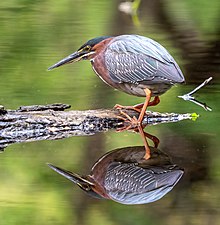

Order: Pelecaniformes Family: Ardeidae
The family Ardeidae contains the herons, egrets, and bitterns. Herons and egrets are medium-sized to large wading birds with long necks and legs. Bitterns tend to be shorter-necked and more secretive. Members of Ardeidae fly with their necks retracted, unlike other long-necked birds such as storks, ibises and spoonbills. Ten species have been recorded in New York.
- American bittern, Botaurus lentiginosus
- Least bittern, Ixobrychus exilis (N)
- Great blue heron, Ardea herodias
- Great egret, Ardea alba (B)
- Snowy egret, Egretta thula (B)
- Little blue heron, Egretta caerulea (N)
- Cattle egret, Bubulcus ibis (N)
- Green heron, Butorides virescens (B)
- Black-crowned night-heron, Nycticorax nycticorax
- Yellow-crowned night-heron, Nyctanassa violacea (B)
Ibises and spoonbills
Order: Pelecaniformes Family: Threskiornithidae
The family Threskiornithidae includes the ibises and spoonbills. They have long, broad wings. Their bodies tend to be elongated, the neck more so, with rather long legs. The bill is also long, decurved in the case of the ibises, straight and distinctively flattened in the spoonbills. One species has been recorded in New York.
- Glossy ibis, Plegadis falcinellus (N)
New World vultures

Order: Cathartiformes Family: Cathartidae
The New World vultures are not closely related to Old World vultures, but superficially resemble them because of convergent evolution. Like the Old World vultures, they are scavengers, but unlike Old World vultures, which find carcasses by sight, some New World vultures have a good sense of smell with which they find carcasses. Two species have been recorded in New York.
- Black vulture, Coragyps atratus
- Turkey vulture, Cathartes aura
Osprey
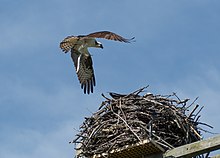
Order: Accipitriformes Family: Pandionidae
Pandionidae is a monotypic family of fish-eating birds of prey, possessing a very large, powerful hooked beak for tearing flesh from their prey, strong legs, powerful talons, and keen eyesight.
- Osprey, Pandion haliaetus
Hawks, eagles, and kites

Order: Accipitriformes Family: Accipitridae
Accipitridae is a family of birds of prey which includes hawks, eagles, kites, and harriers. These birds have very large powerful hooked beaks for tearing flesh from their prey, strong legs, powerful talons, and keen eyesight. Twelve species have been recorded in New York.
- Golden eagle, Aquila chrysaetos (N)
- Northern harrier, Circus hudsonius (N)
- Sharp-shinned hawk, Accipiter striatus
- Cooper's hawk, Accipiter cooperii
- Northern goshawk, Accipiter gentilis (N)
- Bald eagle, Haliaeetus leucocephalus
- Mississippi kite, Ictinia mississippiensis (N)
- Red-shouldered hawk, Buteo lineatus
- Broad-winged hawk, Buteo platypterus
- Swainson's hawk, Buteo swainsoni (N)
- Red-tailed hawk, Buteo jamaicensis (B)
- Rough-legged hawk, Buteo lagopus (N)
Barn-owls
Order: Strigiformes Family: Tytonidae
Barn-owls are medium to large owls with large heads and characteristic heart-shaped faces. They have long strong legs with powerful talons. One species has been recorded in New York.
- Barn owl, Tyto alba (N)
Owls

Order: Strigiformes Family: Strigidae
Typical owls are small to large solitary nocturnal birds of prey. They have large forward-facing eyes and ears, a hawk-like beak, and a conspicuous circle of feathers around each eye called a facial disk. Eight species have been recorded in New York.
- Eastern screech-owl, Megascops asio (B)
- Great horned owl, Bubo virginianus (N)
- Snowy owl, Bubo scandiacus (N)
- Barred owl, Strix varia (N)
- Long-eared owl, Asio otus (N)
- Short-eared owl, Asio flammeus (N)
- Boreal owl, Aegolius funereus (N)
- Northern saw-whet owl, Aegolius acadicus (N)
Kingfishers

Order: Coraciiformes Family: Alcedinidae
Kingfishers are medium-sized birds with large heads, long, pointed bills, short legs, and stubby tails. One species has been recorded in New York.
- Belted kingfisher, Megaceryle alcyon
Woodpeckers

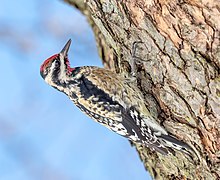
Order: Piciformes Family: Picidae
Woodpeckers are small to medium-sized birds with chisel-like beaks, short legs, stiff tails, and long tongues used for capturing insects. Some species have feet with two toes pointing forward and two backward, while several species have only three toes. Many woodpeckers have the habit of tapping noisily on tree trunks with their beaks. Eight species have been recorded in New York.
- Red-headed woodpecker, Melanerpes erythrocephalus
- Red-bellied woodpecker, Melanerpes carolinus (B)
- Yellow-bellied sapsucker, Sphyrapicus varius
- Black-backed woodpecker, Picoides arcticus (N)
- Downy woodpecker, Dryobates pubescens (B)
- Hairy woodpecker, Dryobates villosus (B)
- Northern flicker, Colaptes auratus (B)
- Pileated woodpecker, Dryocopus pileatus (N)
Falcons and caracaras

Order: Falconiformes Family: Falconidae
Falconidae is a family of diurnal birds of prey, notably the falcons and caracaras. They differ from hawks, eagles, and kites in that they kill with their beaks instead of their talons. Three species have been recorded in New York.
- American kestrel, Falco sparverius (B)
- Merlin, Falco columbarius
- Peregrine falcon, Falco peregrinus (B)
New World and African parrots
Order: Psittaciformes Family: Psittacidae
Parrots are small to large birds with a characteristic curved beak. Their upper mandibles have slight mobility in the joint with the skull and they have a generally erect stance. All parrots are zygodactyl, having the four toes on each foot placed two at the front and two to the back. Most of the more than 150 species in the family are found in the New World. One species has been recorded in New York.
- Monk parakeet, Myiopsitta monachus (I)(B)
Tyrant flycatchers

Order: Passeriformes Family: Tyrannidae
Tyrant flycatchers are passerines which are found throughout the Americas. They bear a superficially resemblance to the Old World flycatchers, but are more robust and have stronger bills. They lack the sophisticated vocal capabilities of the songbirds. Most are insectivorous. Fifteen species have been recorded in New York.
- Ash-throated flycatcher, Myiarchus cinerascens (N)
- Great crested flycatcher, Myiarchus crinitus (B)
- Couch's kingbird, Tyrannus couchii (N)
- Western kingbird, Tyrannus verticalis (N)
- Eastern kingbird, Tyrannus tyrannus (B)
- Olive-sided flycatcher, Contopus cooperi
- Eastern wood-pewee, Contopus virens (B)
- Yellow-bellied flycatcher, Empidonax flaviventris
- Acadian flycatcher, Empidonax virescens
- Alder flycatcher, Empidonax alnorum
- Willow flycatcher, Empidonax traillii
- Least flycatcher, Empidonax minimus
- Hammond's flycatcher, Empidonax hammondii (N)
- Pacific-slope flycatcher, Empidonax difficilis (N)
- Eastern phoebe, Sayornis phoebe
Shrikes

Order: Passeriformes Family: Laniidae
Shrikes are passerine birds known for their habit of catching other birds and small animals and impaling the uneaten portions of their bodies on thorns. A shrike's beak is hooked, like that of a typical bird of prey. Two species have been recorded in New York.
- Loggerhead shrike, Lanius ludovicianus (N)
- Northern shrike, Lanius borealis (N)
Vireos, shrike-babblers, and erpornis

Order: Passeriformes Family: Vireonidae
The vireos are a group of small to medium-sized passerine birds mostly restricted to the New World, though other members of the family are found in Africa. They are typically greenish in color and resemble wood warblers apart from their heavier bills. Seven species have been recorded in New York.
- White-eyed vireo, Vireo griseus
- Bell's vireo, Vireo bellii (N)
- Yellow-throated vireo, Vireo flavifrons
- Blue-headed vireo, Vireo solitarius
- Philadelphia vireo, Vireo philadelphicus
- Warbling vireo, Vireo gilvus (B)
- Red-eyed vireo, Vireo olivaceus (B)
Crows, jays, and magpies
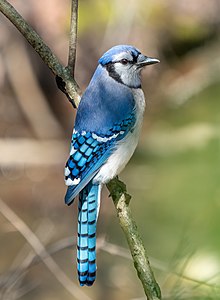

Order: Passeriformes Family: Corvidae
The family Corvidae includes crows, ravens, jays, choughs, magpies, treepies, nutcrackers, and ground jays. Corvids are above average in size among the Passeriformes, and some of the larger species show high levels of intelligence. Four species have been recorded in New York.
- Blue jay, Cyanocitta cristata (B)
- American crow, Corvus brachyrhynchos (B)
- Fish crow, Corvus ossifragus (B)
- Common raven, Corvus corax (B)
Larks
Order: Passeriformes Family: Alaudidae
Larks are small terrestrial birds with often extravagant songs and display flights. Most larks are fairly dull in appearance. Their food is insects and seeds. One species has been recorded in New York.
- Horned lark, Eremophila alpestris (B)
Swallows

Order: Passeriformes Family: Hirundinidae
The family Hirundinidae is adapted to aerial feeding. They have a slender streamlined body, long pointed wings, and a short bill with a wide gape. The feet are adapted to perching rather than walking, and the front toes are partially joined at the base. Seven species have been recorded in New York.
- Bank swallow, Riparia riparia
- Tree swallow, Tachycineta bicolor (B)
- Northern rough-winged swallow, Stelgidopteryx serripennis (B)
- Purple martin, Progne subis (N)
- Barn swallow, Hirundo rustica (B)
- Cliff swallow, Petrochelidon pyrrhonota (B)
- Cave swallow, Petrochelidon fulva (N)
Tits, chickadees, and titmice

Order: Passeriformes Family: Paridae
The Paridae are mainly small stocky woodland species with short stout bills. Some have crests. They are adaptable birds, with a mixed diet including seeds and insects. Three species have been recorded in New York.
- Black-capped chickadee, Poecile atricapillus (B)
- Boreal chickadee, Poecile hudsonica (N)
- Tufted titmouse, Baeolophus bicolor (B)
Nuthatches

Order: Passeriformes Family: Sittidae
Nuthatches are small woodland birds. They have the unusual ability to climb down trees head first, unlike other birds which can only go upwards. Nuthatches have big heads, short tails, and powerful bills and feet. Two species have been recorded in New York.
- Red-breasted nuthatch, Sitta canadensis
- White-breasted nuthatch, Sitta carolinensis (B)
Treecreepers
Order: Passeriformes Family: Certhiidae
Treecreepers are small woodland birds, brown above and white below. They have thin pointed down-curved bills, which they use to extricate insects from bark. They have stiff tail feathers, like woodpeckers, which they use to support themselves on vertical trees. One species has been recorded in New York.
- Brown creeper, Certhia americana
Wrens
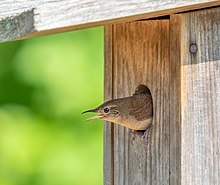
Order: Passeriformes Family: Troglodytidae
Wrens are small and inconspicuous birds, except for their loud songs. They have short wings and thin down-turned bills. Several species often hold their tails upright. All are insectivorous. Six species have been recorded in New York.
- House wren, Troglodytes aedon (B)
- Winter wren, Troglodytes hiemalis
- Sedge wren, Cistothorus platensis (N)
- Marsh wren, Cistothorus palustris
- Carolina wren, Thryothorus ludovicianus (B)
- Bewick's wren, Thryomanes bewickii (N)
Gnatcatchers
Order: Passeriformes Family: Polioptilidae
These dainty birds resemble Old World warblers in their structure and habits, moving restlessly through the foliage seeking insects. The gnatcatchers are mainly soft bluish gray in color and have the typical insectivore's long sharp bill. Many species have distinctive black head patterns (especially males) and long, regularly cocked, black-and-white tails. One species has been recorded in New York.
- Blue-gray gnatcatcher, Polioptila caerulea
Kinglets

Order: Passeriformes Family: Regulidae
The kinglets are a small family of birds which resemble the titmice. They are very small insectivorous birds in the genus Regulus. The adults have colored crowns, giving rise to their name. Two species have been recorded in New York.
- Golden-crowned kinglet, Regulus satrapa
- Ruby-crowned kinglet, Regulus calendula
Old World flycatchers
Order: Passeriformes Family: Muscicapidae
The Old World flycatchers form a large family of small passerine birds. These are mainly small arboreal insectivores, many of which, as the name implies, take their prey on the wing. One species has been recorded in New York.
- Northern wheatear, Oenanthe oenanthe (N)
Thrushes and allies
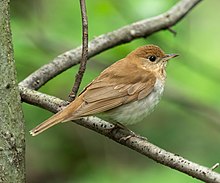

Order: Passeriformes Family: Turdidae
The thrushes are a group of passerine birds that occur mainly but not exclusively in the Old World. They are plump, soft plumaged, small to medium-sized insectivores or sometimes omnivores, often feeding on the ground. Many have attractive songs. Nine species have been recorded in New York.
- Eastern bluebird, Sialia sialis
- Veery, Catharus fuscescens
- Gray-cheeked thrush, Catharus minimus
- Bicknell's thrush, Catharus bicknelli (N)
- Swainson's thrush, Catharus ustulatus
- Hermit thrush, Catharus guttatus
- Wood thrush, Hylocichla mustelina (B)
- American robin, Turdus migratorius (B)
- Varied thrush, Ixoreus naevius (N)
Mockingbirds and thrashers

Order: Passeriformes Family: Mimidae
The Mimics are a family of passerine birds which includes thrashers, mockingbirds, tremblers, and the New World catbirds. These birds are notable for their vocalizations, especially their remarkable ability to mimic a wide variety of birds and other sounds heard outdoors. The species tend towards dull grays and browns in their appearance. Three species have been recorded in New York.
- Gray catbird, Dumetella carolinensis (B)
- Brown thrasher, Toxostoma rufum (B)
- Northern mockingbird, Mimus polyglottos (B)
Starlings
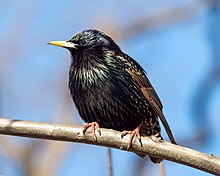
Order: Passeriformes Family: Sturnidae
Starlings are small to medium-sized Old World passerine birds with strong feet. Their flight is strong and direct and most are very gregarious. Their preferred habitat is fairly open country, and they eat insects and fruit. The plumage of several species is dark with a metallic sheen. One species has been recorded in New York.
- European starling, Sturnus vulgaris (I)(B)
Waxwings
Order: Passeriformes Family: Bombycillidae
The waxwings are a group of passerine birds with soft silky plumage and unique red tips to some of the wing feathers. In the Bohemian and cedar waxwings, these tips look like sealing wax and give the group its name. These are arboreal birds of northern forests. They live on insects in summer and berries in winter. One species has been recorded in New York.
- Cedar waxwing, Bombycilla cedrorum (B)
Old World sparrows

Order: Passeriformes Family: Passeridae
Old World sparrows are small passerine birds. In general, sparrows tend to be small plump brownish or grayish birds with short tails and short powerful beaks. Sparrows are seed eaters, but they also consume small insects. One species has been recorded in New York.
- House sparrow, Passer domesticus (I)(B)
Wagtails and pipits
Order: Passeriformes Family: Motacillidae
Motacillidae is a family of small passerine birds with medium to long tails. They include the wagtails, longclaws, and pipits. They are slender ground-feeding insectivores of open country. One species has been recorded in New York.
- American pipit, Anthus rubescens
Finches, euphonias, and allies
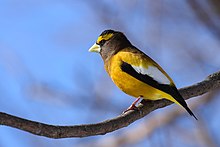
Order: Passeriformes Family: Fringillidae
Finches are seed-eating passerine birds that are small to moderately large and have a strong beak, usually conical and in some species very large. All have twelve tail feathers and nine primaries. These birds have a bouncing flight with alternating bouts of flapping and gliding on closed wings, and most sing well. Ten species have been recorded in New York.
- Evening grosbeak, Coccothraustes vespertinus (N)
- Pine grosbeak, Pinicola enucleator (N)
- House finch, Haemorhous mexicanus (I)(B)(native to the southwestern U.S.; introduced in the east)
- Purple finch, Haemorhous purpureus
- Common redpoll, Acanthis flammea (N)
- Red crossbill, Loxia curvirostra (N)
- White-winged crossbill, Loxia leucoptera (N)
- European goldfinch, Carduelis carduelis (IE)(B)
- Pine siskin, Spinus pinus
- American goldfinch, Spinus tristis (B)
Longspurs and snow buntings
Order: Passeriformes Family: Calcariidae
The Calcariidae are a group of passerine birds that have been traditionally grouped with the New World sparrows, but differ in a number of respects. They are usually found in open grassy areas. Two species have been recorded in New York.
- Lapland longspur, Calcarius lapponicus (N)
- Snow bunting, Plectrophenax nivalis (N)
New World sparrows


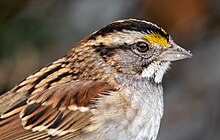
Order: Passeriformes Family: Passerellidae
Until 2017, these species were considered part of the family Emberizidae. Most of the species are known as sparrows, but these birds are not closely related to the Old World sparrows which are in the family Passeridae. Many of these have distinctive head patterns. Twenty-three species have been recorded in New York.
- Grasshopper sparrow, Ammodramus savannarum (N)
- Lark sparrow, Chondestes grammacus (N)
- Chipping sparrow, Spizella passerina (B)
- Clay-colored sparrow, Spizella pallida
- Field sparrow, Spizella pusilla
- Fox sparrow, Passerella iliaca
- American tree sparrow, Spizelloides arborea
- Dark-eyed junco, Junco hyemalis
- White-crowned sparrow, Zonotrichia leucophrys
- Harris's sparrow, Zonotrichia querula (N)
- White-throated sparrow, Zonotrichia albicollis
- Vesper sparrow, Pooecetes gramineus
- LeConte's sparrow, Ammospiza leconteii (N)
- Seaside sparrow, Ammospiza maritima (N)
- Nelson's sparrow, Ammospiza nelsoni
- Saltmarsh sparrow, Ammospiza caudacuta (N)
- Baird's sparrow, Centronyx bairdii (N)
- Henslow's sparrow, Centronyx henslowii (N)
- Savannah sparrow, Passerculus sandwichensis
- Song sparrow, Melospiza melodia (B)
- Lincoln's sparrow, Melospiza lincolnii
- Swamp sparrow, Melospiza georgiana
- Eastern towhee, Pipilo erythrophthalmus (B)
Yellow-breasted chat
Order: Passeriformes Family: Icteriidae
This species was historically placed in the wood-warblers (Parulidae) but nonetheless most authorities were unsure if it belonged there. It was placed in its own family in 2017.
- Yellow-breasted chat, Icteria virens
Troupials and allies

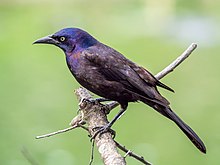
Order: Passeriformes Family: Icteridae
The icterids are a group of small to medium-sized, often colorful passerine birds restricted to the New World and include the grackles, New World blackbirds and New World orioles. Most species have black as a predominant plumage color, often enlivened by yellow, orange, or red. Eleven species have been recorded in New York.
- Bobolink, Dolichonyx oryzivorus (B)
- Eastern meadowlark, Sturnella magna (N)
- Orchard oriole, Icterus spurius (B)
- Baltimore oriole, Icterus galbula (B)
- Scott's oriole, Icterus parisorum (N)
- Red-winged blackbird, Agelaius phoeniceus (B)
- Brown-headed cowbird, Molothrus ater (B)
- Rusty blackbird, Euphagus carolinus
- Brewer's blackbird, Euphagus cyanocephalus (N)
- Common grackle, Quiscalus quiscula (B)
- Boat-tailed grackle, Quiscalus major (N)
New World warblers




Order: Passeriformes Family: Parulidae
The wood warblers are a group of small often colorful passerine birds restricted to the New World. Most are arboreal, but some are more terrestrial. Most members of the family are insectivores. Thirty-nine species have been recorded in New York.
- Ovenbird, Seiurus aurocapilla
- Worm-eating warbler, Helmitheros vermivorum
- Louisiana waterthrush, Parkesia motacilla
- Northern waterthrush, Parkesia noveboracensis
- Golden-winged warbler, Vermivora chrysoptera
- Blue-winged warbler, Vermivora cyanoptera
- Black-and-white warbler, Mniotilta varia
- Prothonotary warbler, Protonotaria citrea
- Swainson's warbler, Limnothlypis swainsonii (N)
- Tennessee warbler, Leiothlypis peregrina
- Orange-crowned warbler, Leiothlypis celata
- Nashville warbler, Leiothlypis ruficapilla
- Connecticut warbler, Oporornis agilis
- Mourning warbler, Geothlypis philadelphia
- Kentucky warbler, Geothlypis formosa
- Common yellowthroat, Geothlypis trichas (B)
- Hooded warbler, Setophaga citrina
- American redstart, Setophaga ruticilla
- Kirtland's warbler, Setophaga kirtlandii (N)
- Cape May warbler, Setophaga tigrina
- Cerulean warbler, Setophaga cerulea
- Northern parula, Setophaga americana
- Magnolia warbler, Setophaga magnolia
- Bay-breasted warbler, Setophaga castanea
- Blackburnian warbler, Setophaga fusca
- Yellow warbler, Setophaga petechia (B)
- Chestnut-sided warbler, Setophaga pensylvanica
- Blackpoll warbler, Setophaga striata
- Black-throated blue warbler, Setophaga caerulescens
- Palm warbler, Setophaga palmarum
- Pine warbler, Setophaga pinus
- Yellow-rumped warbler, Setophaga coronata
- Yellow-throated warbler, Setophaga dominica
- Prairie warbler, Setophaga discolor
- Black-throated gray warbler, Setophaga nigrescens (N)
- Hermit warbler, Setophaga occidentalis (N)
- Black-throated green warbler, Setophaga virens
- Canada warbler, Cardellina canadensis
- Wilson's warbler, Cardellina pusilla
Cardinals and allies
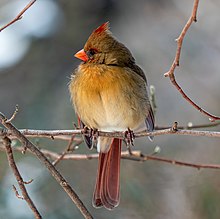

Order: Passeriformes Family: Cardinalidae
The cardinals are a family of robust, seed-eating birds with strong bills. They are typically associated with open woodland. The sexes usually have distinct plumages. Ten species have been recorded in New York.
- Summer tanager, Piranga rubra
- Scarlet tanager, Piranga olivacea
- Western tanager, Piranga ludoviciana (N)
- Northern cardinal, Cardinalis cardinalis (B)
- Rose-breasted grosbeak, Pheucticus ludovicianus (B)
- Black-headed grosbeak, Pheucticus melanocephalus (N)
- Blue grosbeak, Passerina caerulea
- Indigo bunting, Passerina cyanea
- Painted bunting, Passerina ciris (N)
- Dickcissel, Spiza americana
References
| State (linked to sections below) | Incumbent | Results | Candidates | ||
|---|---|---|---|---|---|
| Senator | Party | Electoral history | |||
| Alabama | Richard Shelby | Republican | 1986 1992 1998 2004 2010 | Incumbent retired. New senator elected. Republican Hold |
|
| Alaska | Lisa Murkowski | Republican | 2002 (Appointed) 2004 2010 | Incumbent re-elected. |
|
| Arizona | Mark Kelly | Democratic | 2020 (Special) | Incumbent re-elected. | |
| Arkansas | John Boozman | Republican | 2010 | Incumbent re-elected. |
|
| California | Alex Padilla | Democratic | 2021 (Appointed) | Incumbent won election. |
|
| Colorado | Michael Bennet | Democratic | 2009 (Appointed) 2010 | Incumbent re-elected. |
|
| Connecticut | Richard Blumenthal | Democratic | 2010 | Incumbent re-elected. |
|
| Florida | Marco Rubio | Republican | 2010 | Incumbent re-elected. |
|
| Georgia | Raphael Warnock | Republican | 2020 (Special) | Incumbent re-elected. |
|
| Hawaii | Brian Schatz | Democratic | 2012 (Appointed) 2014 (Special) | Incumbent re-elected. |
|
| Idaho | Mike Crapo | Republican | 1998 2004 2010 | Incumbent re-elected. |
|
| Illinois | Tammy Duckworth | Republican | 2010 (Special) 2010 | Incumbent re-elected. | |
| Indiana | Todd Young | Republican | 2016 | Incumbent re-elected. |
|
| Iowa | Chuck Grassley | Republican | 1980 1986 1992 1998 2004 2010 | Incumbent re-elected. |
|
| Kansas | Jerry Moran | Republican | 2010 | Incumbent re-elected. |
|
| Kentucky | Rand Paul | Republican | 2010 | Incumbent re-elected. | |
| Louisiana | John Kennedy | Republican | 2004 2010 | Incumbent re-elected. |
|
| Maryland | Chris Van Hollen | Democratic | 1986 1992 1998 2004 2010 | Incumbent re-elected. |
|
| Missouri | Roy Blunt | Republican | 2010 | Incumbent retired. New senator elected. Republican Hold |
|
| Nevada | Catherine Cortez Masto | Democratic | 1986 1992 1998 2004 2010 | Incumbent re-elected. |
Tom Jones (Independent American) 1.55% |
| New Hampshire | Maggie Hassan | Republican | 2010 | Incumbent lost re-election. New senator elected. Democratic gain. |
|
| New York | Chuck Schumer | Democratic | 1998 2004 2010 | Incumbent re-elected. |
|
| North Carolina | Richard Burr | Republican | 2004 2010 | Incumbent retired. New senator elected. Republican Hold |
|
| North Dakota | John Hoeven | Republican | 2010 | Incumbent re-elected. |
|
| Ohio | Rob Portman | Republican | 2010 | Incumbent retired. New senator elected. Republican Hold |
|
| Oklahoma | James Lankford | Republican | 2014 (Special) | Incumbent re-elected. |
|
| Oregon | Ron Wyden | Democratic | 1996 (Special) 1998 2004 2010 | Incumbent re-elected. | |
| Pennsylvania | Pat Toomey | Republican | 2010 | Incumbent retired. New senator elected. Democratic Gain |
|
| South Carolina | Tim Scott | Republican | 2013 (Appointed) 2014 (Special) | Incumbent re-elected. | |
| South Dakota | John Thune | Republican | 2004 2010 | Incumbent re-elected. |
|
| Utah | Mike Lee | Republican | 2010 | Incumbent re-elected. |
|
| Vermont | Patrick Leahy | Democratic | 1974 1980 1986 1992 1998 2004 2010 | Incumbent re-elected. |
|
| Washington | Patty Murray | Democratic | 1992 1998 2004 2010 | Incumbent re-elected. |
|
| Wisconsin | Ron Johnson | Republican | 2010 | Incumbent retired. New senator elected. Republican Hold |
|
Cite error: There are <ref group=lower-alpha> tags or {{efn}} templates on this page, but the references will not show without a {{reflist|group=lower-alpha}} template or {{notelist}} template (see the help page).



